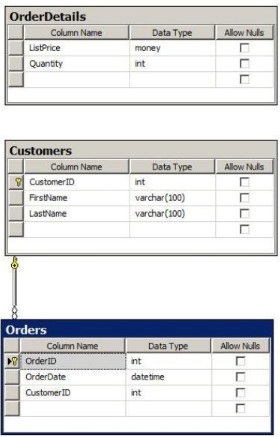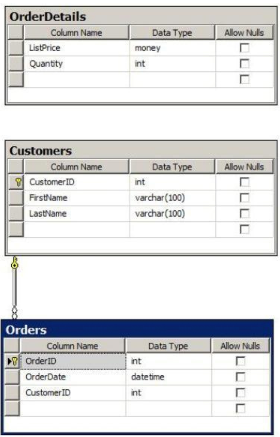READ Free Dumps For Microsoft- 70-461
| Question ID 15153 | You have a database named Sales that contains the tables as shown in the exhibit. (Click
the Exhibit button.)

You need to create a query for a report. The query must meet the following requirements:
✑ Return the last name of the customer who placed the order.
✑ Return the most recent order date for each customer.
✑ Group the results by CustomerID.
✑ Order the results by the most recent OrderDate.
✑ Use the database name and table name for any table reference.
✑ Use the first initial of the table as an alias when referencing columns in a table.
The solution must support the ANSI SQL-99 standard and must NOT use object identifiers.
Part of the correct T-SQL statement has been provided in the answer area. Complete the
SQL statement.

|
| Option A | Answer : Please check the explanation part for the solution answer as.
|
| Correct Answer | A |
Explanation Explanation: SELECT o.LastName, MAX (o.OrderData) AS MostRecentOrderData FROM Sales.Orders AS o GROUP BY o.CustomerID ORDER BY o.OrderDate DESC
| Question ID 15154 | You have a database named Sales that contains the tables as shown in the exhibit. (Click
the Exhibit button.)

You need to create a query for a report. The query must meet the following requirements:
✑ Return the last name of the customer who placed the order.
✑ Return the most recent order date for each customer.
✑ Group the results by CustomerID.
✑ Order the results by the most recent OrderDate.
✑ Use the database name and table name for any table reference.
✑ Use the first initial of the table as an alias when referencing columns in a table.
The solution must support the ANSI SQL-99 standard and must NOT use object identifiers.
Part of the correct T-SQL statement has been provided in the answer area. Complete the
SQL statement.

|
| Option A | Answer : Please check the explanation part for the solution answer as.
|
| Correct Answer | A |
Explanation Explanation: SELECT o.LastName, MAX (o.OrderData) AS MostRecentOrderData FROM Sales.Orders AS o GROUP BY o.CustomerID ORDER BY o.OrderDate DESC